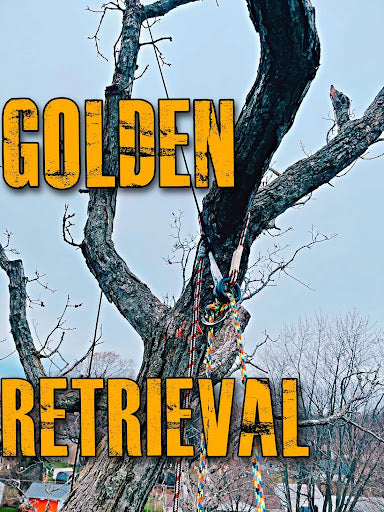
The Golden Retrieval Canopy Anchor
Canopy Anchors: you either love them or hate them! I tend to enjoy setting a good solid canopy anchor. Sure, it takes a little bit longer to isolate a union, but if you look on the positive side, it can help solidify your throwline skills.
Getting your throwline game up there is one of the fundamental keys to climbing. By no means am I an expert on throwlines. There are days where I am hitting my target on the first shot and there will be days where the struggle is real.
First, I’ll be focusing on my favorite canopy anchor, the golden retrieval. This doesn’t mean that there is something wrong with basal anchors. Both options are solid. Which anchor you use really depends on your personal preferences, tree species you're working on, and which union you decide to choose as your canopy anchor point.
So, why else would I choose a canopy anchor over a basal? Honestly, at first I was doing a lot of basal anchoring until I began venturing into contract climbing. That right there led me to switch it up to canopy anchors, for a while. Why did contract climbing push me to canopies, you might ask? During the normal work operation, I have a standard crew that know my climbing style along with my habits and I know theirs.
Contracting has you going out working with new people that you haven’t worked with before and you won’t know their work habits until you’ve worked with them long enough. So, in order to keep my focus on the task given and not diverting my focus constantly to my basal, I felt that a canopy anchor would be the best route until I got to know their crew member’s habits. Once that trust gets established, then I began switching my style around. Even after we established solid communication and trust, I just ended up growing super fond of canopy anchors, especially for large prunes. I’ll occasionally still throw down on a basal anchor for quick tasks.

After experimenting with an Alpine butterfly ring and Texas Tug anchor, there really is one that I prefer above them all and that is the Golden Retrieval! To successfully use this canopy anchor, an adjustable friction saver and an extra carabiner is required. However, I recently experimented with a Floating Anchor, and it’s a pretty damn close second. Simple and not confusing on setup. What more can you ask for, am I right? Anyway, back to the Golden Retrieval. Normally, I would get my line set and send up a Running Bowline with a Yosemite tie off, then run up to switch my set up around. Until a good friend of mine showed me how to do that with a method of staying on rope.
I would still set up my line the same way with the Running Bowline but now I would leave extra tail on the Bowline. Next step, I join the bitter end of my rope to the tail of my Bowline. On the bitter end I’ll have my wrench set up along with an anchor retrieval rope in a bag. Smell what I’m cooking so far? All of that gets sent up to the TIP, waiting for me to configure my final canopy anchor set up. I’ll ascend up on my Akimbo and do some work along the way to the TIP. Once at my TIP, I remain on rope as I configure my Golden Anchor. Install the friction saver as normal, jam the small ring side with an Alpine Butterfly and capture the loop along with the leg of rope running down to the ground with that extra carabiner. Yes, you can set it from the ground although I prefer to inspect the union that I am to anchor off of. Plus, setting the additional soft retrieval leg gets done manually (the retrieval leg is a 6mm cord).

Yes, it is a bit gear heavy and does require a bit more time. With enough repetition though it can become quick and easy to install. As I mentioned at the start of this here blog, it’s my favorite and I can get a few more redirects than an Alpine Butterfly ring anchor. I do understand that everybody has their own style/preferences on how they do things, and this may not be for them. If you are on the quest for new climbing techniques and haven’t tried this, then maybe it’s worth giving it a shot. Anyways, happy climbing!

Leave a comment